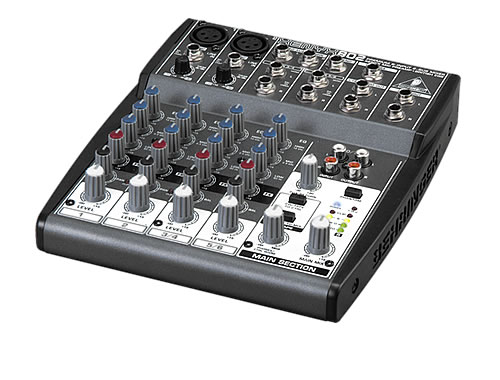Podcasting and Videocasting
Although unpowered vocal microphones are not the best solution for Audio or Video Podcasting I have managed to get some pretty good results out of a pair of Sennheiser “e” series microphones hooked up to a mixing desk and mixed into Garageband.
The microphones are the Sennheiser e840 (£55.99 at DV247.com and the Sennheiser e815s (£25.99 at DV247.com), the “s” stands for Switch so the 815s boasts a hard on-off switch on the microphone itself whilst the superior 840 does not (there is a version of the 840 with a switch).
The two microphones are remarkably similar in build quality and both have an excellent, quality re-assuring weight thanks to their solid metal casing.
When recording a Podcast it’s worth spending a little cash- perhaps £100 -and getting yourself a reasonably good microphone and an audio interface. If you plan to have more than one host then a microphone per person is almost essential for the best possible quality. Crowing around a single laptop microphone will sound abysmal no matter how many filters you try.
Recording multiple hosts almost certainly requires a suitable mixing desk or an audio interface with multiple inputs. You will find that a mixing desk gives you better control and lets you set and forget levels for each host which you can then use with any recording software. You can also enhance your podcast by adjusting the panning on individual hosts to create a more natural sound stage and emphasize the identity of individuals in a conversation.

There are mixing desks which combine traditional mixing functionality with Firewire or USB audio interfaces. But it’s difficult to start small with these; if you have plans to upgrade in future extra expense may be incurred replacing the kit. The Behringer XENYX 802 is a good starting point for mixing two hosts and the XENYX 1202 will give you 4 XLR inputs for Microphones and plenty of room for instruments and feeds from other computers to boot.
Behringer also have a good value Condenser microphone bundle in the form of the C-2 Studio Condenser Microphones which are perfectly suited for a two host Podcast and a compact Compressor, the Behringer COM800, that retails for about £35 and will give you that extra quality edge and allow you to keep software filters to an absolute minimum.
Once you’re equipped with the right hardware, getting a good sound out of Garageband involves a little trial and error combined with a working knowledge of the software filters and effects available. I used the following settings:
- The Gate filter enabled and set to approximately 40%. Your mileage will vary here but the Gate filter is almost essential if you want to eliminate noise during brief pauses in dialogue. The Gate filter does not suffice alone, however, and must be used in conjunction with other filters to eliminate the jarring difference between background noise during speech and total silence.
- If you create a Podcast project in Garageband it will add two Speech Enhanced tracks by default, Male and Female. My preference is the default Male Radio filter which can be selected when you add a “Speech Enhancer” to a track. The Speech Enhancer serves to dampen all but the most aggressive noise, with your own speech effectively drowning out the rest.
- I like to turn on the compressor and select “Vocal Compression Rap” for a little extra punch, this is done in combination with a slight bass boost on the mixing desk 3-band equalizer and dampening of the high frequencies which also serves to reduce noise but can have undesirable effects on speech if used too liberally. What can I say? I like to pretend I have a rich, deep, bassy voice.
Currently with the above filter settings applied to two separate tracks I have managed to connect two Sennheiser Vocal microphones to the mono channels on a Phase x24 (Although you shouldn’t need to spend quite that much on an interface) and have achieved superb noise isolation between both microphones. One can be held up and talked into, whilst the other lies upon the desk picking up nothing but silence. With one single audio interface, a couple of decent but cheap microphones and the right gain/filter settings I’ve achieved superb results.
So, there you have it. Audio is far too often overlooked in Podcasts despite it being absolutely fundamental to production. Good audio quality doesn’t have to beak the bank and mixer/hardware interface setups are not as complex as they might first appear. Achieving a reasonable quality of audio could spell the difference between a successful podcast and just another mediocre bedroom broadcast. You’ll hear more from us about podcasting and videocasting as we churn out our own productions, aiming for the best quality possible on a budget.